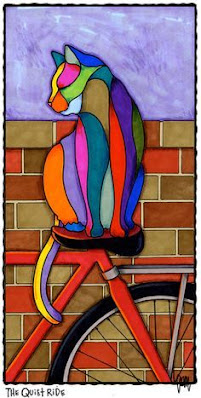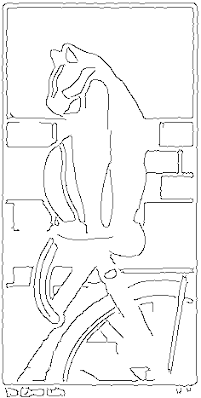

How to Create a Reverse Painting on Glass
Glass is a non-absorbent portray assist which does now not enable the paint to without problems adhere to it - aside from thru the paint's very own drying process.
For this motive, the outlines of a situation painted on glass want to be simplified when applied to an extraordinarily easy glass surface. Simplifying a concern does now not always detract from the give up end result after the portrayal is performed and the ultimate end result can frequently have a look comparable to that of naive artwork in relation to composition and structure and a sure range of different details. Many artists may additionally locate that such simplification can certainly be very appealing.
Working the paint or altering outlines besides smudging the surrounding areas of undried paint might also require some awareness in the beginning, as nicely as a sure quantity of skill, however with persistence and the improvement of their capabilities the use of this portray technique, artists will locate that making use of and learning the use of glass as a guide will emerge as less difficult as time progresses.
MATERIALS REQUIRED FOR PAINTING ON GLASS
Glass
Choose clear unflawed glass (or plexiglass) in the structure and dimension you want to use. In order to start studying the approach of reverse portray it is recommended to pick smaller sizes to commence with.
Paints
It is necessary to use paint that will adhere right to the floor of the glass. Oil primarily based paints or acrylics are regularly used for this reason. There are additionally opaque and obvious ceramic artist shades that have been mainly manufactured for use on a non-absorbent surface. Metallic colours (eg. gold, silver or copper) can additionally be fascinating to work with. There is a growing range of new artwork merchandise reachable nowadays that can also be appropriate for portraying on a non-absorbent floor such as glass.
Paintbrushes
To commence pick a determination of small or medium-sized paintbrushes with fine, flat and pointed tips. Larger brushes can be used for working on a large scale. Artists can additionally use much less traditional equipment for making use of paint if they wish, relying on the consequences bought via experimentation that can also hobby them.
A penholder
Used for outlines (if required) and finer details. It can be a benefit to use interchangeable nibs appropriate for growing each thick and skinny outline.
Ink for developing outlines on glass
The inks used to want to be appropriate for making use of a non-absorbent floor such as glass. As a choice paint can additionally be thinned down into an extra liquid shape and used for developing outlines in which case interest has to be given to developing the proper combination of fluidity and thickness.
A portray palette or something comparable to combine your paint on.
A palette knife -(optional) for mixing paint.
Artists paint cleaner or thinner - used for cleansing or once in a while for thinning, and relying on whether or not oil-based totally or water-based paints are used.
A paint-drying agent - (optional) For mixing with paints to assist pace up the drying process
Paper towelling or some easy rags
A replicate - (optional) can be used to take a look at the growth of your painting whilst you are persevering with to work. Place the reflect in a role the place it will replicate your paintings from its viewing side.
Cellotape - or a comparable average-width sticking tape
An easel - (optional) to prop your work on
A glass-cleaning product
PREPARING THE GLASS
Choose a piece of clear glass in the dimensions you would like to work with and take a look at it cautiously to make positive the glass is neither scratched nor flawed. It is profitable to remember that a flaw in the glass itself will frequently detract from the completed look of a portrait and might also be not possible to do away with after the completion of your artwork.
The sheet of glass that is to grow to be your artwork constitutes the following:
(1) The 'painting side' - which is the facet you will be portrayed on.
(2) The 'viewing side' - which is the aspect you will be searching at (or through) as you develop with your work and after it has been completed.
To render the reducing edges of the glass protected take a size of sellotape that will correspond to the size of one edge. Apply it cautiously alongside that size (ideally so that it is folded equally over every facet of the glass).
Repeat this system for the different three glass edges. The aspect of the sellotape will additionally help mark the outer limits of your artwork.
Clean the floor of the glass utterly with a glass-cleaning product. Use paper towelling or any cleansing cloth that will now not depart dirt or threads on your portray surface.
Store the glass in a place it will be safe. If positioned between sheets of newspaper it will be included from scratches and dust.
CREATING OUTLINES
Art merchandise in liquid shapes that is appropriate for developing outlines on glass can also be effortlessly handy in some countries. Oil-based paint, water-based acrylic and ceramic paint can additionally be used for this purpose. In order to create first-class traces, these paints need to now and again be thinned down in order to use with a pen nib or comparable line-drawing tool.
To stop traces from being effaced too without difficulty you can use a paint that is oil-primarily based for growing the outlines of your situation if the paint you will be making use of over the pinnacle of it (after it has well dried) is water-based. Reverse this process if your outlines are created with water-based paint.
Always use a liquid paint product that will furnish the pleasant adhesion feasible to a glass surface.
Due to pen nibs clogging pretty easily, interest has to be paid to clean the nibs regularly.
OUTLINE METHODS
Method 1.
If you have a consistent hand you can use a freehand approach for making use of outlines without delay onto the floor of the glass.
Method 2.
Use an authentic challenge for your portrait (e.g. a drawing) and location this beneath the glass then replica it onto the glass surface.
Method 3.
Place a layer of carbon paper on the pinnacle of the glass then area your drawing on the pinnacle of the carbon paper and with a pointed object hint the difficulty onto the glass. Be cautious no longer to harm your unique picture (the picture being copied) when the usage of a pointed object.
Method 4.
A tracing desk can be used for developing outlines. This is a desk with a sheet of clear glass inserted into the pinnacle and with an electric powered mild supply located underneath it. For those who regularly want to hint at their work, a tracing desk can be very realistic and useful.
Method 5.
You can miss outlines altogether.
APPLYING THE PAINT
Most artists have a desire for how to work when developing an artwork. Once it has been determined whether or not to work on a desk or use a table easel or a standing easel, it will be quintessential to view the paintings often from its commentary aspect in order to see their progress.
Some artists really take the glass in their palms and flip it round to appear at it immediately from the commentary side. Others choose to use a reflect positioned immediately contrary to their working location so that they can take a look at their growth whilst they paint.
Mixing and blending
If you are mixing colourations continually do so on a palette or comparable flat object earlier than making use of them in the glass. If shades are no longer nicely blended or combined the end result will be a streaky look in the paint on the statement facet of the glass.
Avoiding smudges
When developing a reverse portrayal on glass it is necessary to watch out for smudges or particles of filth or dirt that may also by accident be transferred onto unpainted areas of your artwork as you are progressing. Unless eliminated these may additionally show up as flaws that will exhibit when viewing the artwork from its statement side. If they are additionally inadvertently blanketed with a layer of paint getting rid of them afterwards might also emerge as very messy and difficult. When lifting off any smudges continually be cautious no longer to harm outlines or different areas of paint you have already applied.
Applying the paint
Once the outlines of your issue have fully dried you can start to observe paint to fill in the rest of your artwork. Begin with the smallest and most distinctive or problematic areas first e.g. eyes, faces, small figures or objects and so forth - and usually hold in the idea that your paintings will be determined from the contrary aspect to the one you portray and that you are portrayed in reverse and that consequently, foregrounds precede backgrounds.
When applying the reverse portray approach it is a desirable coverage to replicate cautiously on the sequence in which your portray will strengthen earlier than commencing to follow your paint. This will create a methodical mindset that is necessary for this in particular fascinating however additionally problematic portray technique.